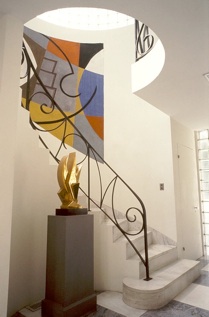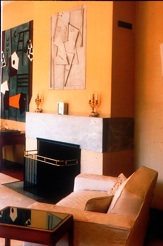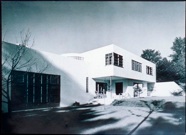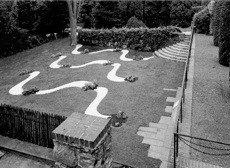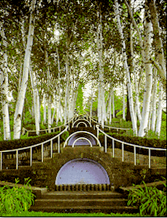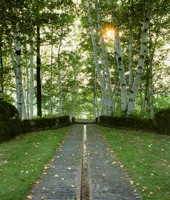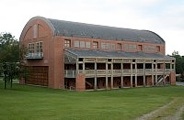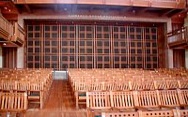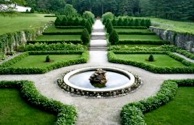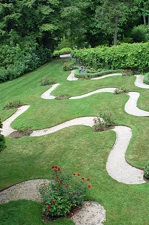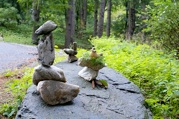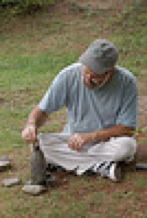arslocii
placeness as art


arslocii
placeness as art





















Quest for artistic endeavor in western Mass.
The initial purpose of visiting the Berkshires was to attend a rock-balancing workshop at the yoga center Kripalu. But there is so much more to see, so we did. The Berkshires are as handsome as the Catskills, and we wondered if they are the very same mountain chain broken by the Hudson River. In actuality they are the southern end of the Green Mountains of Vermont, so, no, the two are just friendly neighbors. These western Massachusetts mountains contain many of their own beautiful vistas and charming towns, along with a definite epicenter of spirituality and, now, New Age thinking.
The Mount
Lenox, MA
Edith Wharton must have been drawn to the beauty as well as the karmic aura of the town. Her house, The Mount, a bit in the mold of a French chateau, is not as pretentious as it seems from its name. In fact, it is rather modest for an ego of her size. One of the best features is the long, wooded and Beatrix Farrand-designed carriage drive that meanders toward the house. Ironically, you can’t and don’t drive on it – your car is instead shunted to an off-site parking area. But that’s okay – you wouldn’t want to do anything but walk the quarter mile through a coiffed, yet so excellently designed naturalistic, shade-covered woodland that seems wild and inevitable. Hello, arslocii. It is, perhaps, the longest allee ever created (Beatrix does it again, for her Aunt Edith this time), and it is probably the most satisfying garden on the property. Finally you reach the forecourt, a compression chamber, walled and rather spare, which resizes the visitor after the inflation and elation felt during the exquisite, forested approach. Going through the house and out the back to the formal gardens is a very different experience, making you realize that you are on a steep hill (hence the name) and, below you, the stepped garden rooms unravel like a stair-descending Slinky. Also it is very sunny and airy on this side, a good location for a vineyard, but the terraced hillside is more of a formal Italianate garden, without grapes but, instead, with a lime allee. One special garden element is the two bookending flights of earthen, grass-covered grand staircases that connect the upper terrace to the lower gardens. These functional artworks are sculptural, looking as if they were just carved out of the existing landscape, both soft and hard, elegant and simple. Other gardens have terraced stairs with grass as a component, but, unlike the others, these are not edged with any perceptible masonry. They are remarkable rounded and geometric objects of grass – a kind of earthwork topiary. Another unique element is the small and intimate pet cemetery. Populated by long-gone beloved dogs, protected and surrounded by a canopy of trees, sitting on a small promontory with a nice prospect of the entire garden -- it is a perfect setting for any dog, living or dead. It is the most special and emotion-filled part of the garden.
Frelinghuysen Morris House & Studio
Lenox, MA
To be honest, we didn’t really know about this place as a destination until we arrived in Lenox. But serendipity is often the best part of exploring a new place, and what a pleasant surprise it was. Two tastes in one – modernist house and artworks by the actual owner/occupants. The house is wonderful; again, as at The Mount, you approach it through a woodland area, although this one is more natural. En route you pass a precarious Cubist sculpture balanced on a cracking dolman structure, an Adirondack-style bridge spanning a creek, paths that lead you into a cool walk through a formerly Victorian-style strolling park. But there, up the hill in the clearing, is the chalk-white stucco and glass-block Bauhausian alien architecture. Modernist buildings never look better than they do in a lovely landscape, highlighting and emphasizing the contrast (so there, you callous modernist architects, you!). It’s a shame that the designers never cared a whit about the site as a balance for the object in it, but it can result in a nice pairing anyway. The interior of the house gets even better, with its streamlined decor and the warm glow of the early 20th century, bathed in incandescent lamplight. Furniture designers of the period are all represented here – among them Frankl, Deskey and Aalto – as are many of the more famous European Cubist artists of the time: Picasso, Braque, Leger, Gris. But this is George Morris and Suzy Frelinghuysen’s place, and their artworks are key to the feel of the house. There are murals, reliefs, sculptures and paintings. As you start to look closely you realize that Suzy was the better painter and that George should have stuck with sculpture but, collectively, their works are an integral part of their environment. And lucky for us, we get to share a glimpse of it. Contrasting their home to the house and studio of Pollock/Krasner, it is remarkable how dissimilar in look and how similar in feel these former residences are. The very stylish, comfortable and design-y but still personal Frelinghuysen Morris digs are a showplace that complement and enhance their own expressive output, whereas the Pollock/Krasner home is spare in a more monastic, almost Shaker style, leaving their art as the single centerpiece of their humble environment. The same difference exists even in their studios: this one, coming off the house, being both a work and a show place.
Tanglewood
Lenox & Stockbridge, MA
The grounds at this world-renowned music venue are lovely. Named after Nathaniel Hawthorne’s book “Tanglewood Tales,” written in a summer-cottage rental nearby, this former estate of the Tappan family has become, since 1937, one of the great summer listening places. It encompasses 210 acres and is a huge park situated in two neighboring cities. Over the years it has improved its structures, starting with a fan-shaped shed in 1938; the Seiji Ozawa Hall was added in 1994. Cutting across the grounds while on an organized Kripalu hike, we stopped to look at the Ozawa Hall, a large shed-like building that resembles a train station or airplane hanger sitting in the middle of a landscaped lawn. Walking under the loggia, the doors were open so we could see inside the cathedral-like space. The seats, the rectilinear walls, the floors, the latticed geometric grids of the open dividers and railings, the massive barn-size doors opening 50’ wide at the back to bring in the green lawn and summer breezes – all built of wood, primarily teak, everything warm and glowy, and the sound must resonate from every surface like a well-made cello. It was a surprisingly delicate space considering its size, a thing of beauty in a setting of beauty. We must return for a listen.
Naumkeag
Stockbridge, MA
The only thing we ever knew about Naumkeag was the iconic image of the Blue Steps in photographs. That image just sums up what arslocii is about – the exquisite pairing of nature’s materials and the built environment. It seems simple, really, putting plant material together with designed infrastructure and getting a good result. We humans do it all the time – often, though, without the blending and transformation that this work of art engenders. This sweeping, cascading staircase and its entourage of white birches create a nearly vertical allee that climbs a steep hillside and resembles a Busby Berkley movie set peopled by trees. What we didn’t know is that, besides being a staircase, it also is a cascading waterfall and fountain with an extremely long runnel at the top of the stairs sending water down through a series of blue-painted arches with mirror-image pools beneath them – kind of like clam shells releasing the water at each level on each descending landing, the stairs splitting and encircling each change of grade. And, of course, the arch motif is repeated above each landing in the simple and elegant iron railing, painted white to reflect the birch trees. When you start to describe it, it sounds simple and dumb, but each element is so attuned to the whole that there is nothing superfluous, a perfect balance, and the elimination of any piece would tip the scale. The Blue Steps are about time and space, the space of nature: the perspective of the eye and the unfolding of time within a landscape. Landscape architect Fletcher Steele achieves this with grace, and the whole is not overwrought with decoration. Like a sweeping staircase on which fashionable debutantes might descend on display for their future destiny, a symbolic wedding cake unfolds. But The Blue Steps, for all their renown, are mundanely functional and situated in a remarkably private area hidden from view from the house. As one of the most elaborate transitions from high ground to the lower forty, the steps lead to the lesser-used parts of the garden; in fact, the cutting garden is their ultimate destination.
The other revelation about Naumkeag is that there is so much more to it in addition to the famous stairs. The gardens were built over a period of 30 years by Steele in conjunction with Mabel Choate, the owner. Other unique spaces and garden rooms that surround the Choate’s “cottage,” built by McKim, Mead and White, include the Rose Garden: one of the cleverest designs, incorporating undulating gravel paths to connect the plants, it is located on a terrace below the main grounds with a kind of loggia built into the retaining wall above, with purple painted railings and support posts, providing views both from above and below. The Chinese Garden is completely walled and resembles a miniature version of an imagined Forbidden City complex, with temples laid out by compass points, accessible by ceremonial stairs and, naturally, a moon gate. The Afternoon Garden, adjacent to the house, has a giant fence of nautical posts connected with rope swags that are capped with colorfully painted finials – the effect being Venetian or Moorish. Within the garden are elaborate boxwood scroll designs mixed with colored gravel and a central oval pool. Of all the theatricality of this landscape, this patio for entertaining is probably the most elaborate in its production value.
Kripalu
Lenox, MA
A note about Kripalu, after a second visit. The massive former seminary is like a dormitory for a New Age university. Its ascetic accommodations prove the point: that nature is the real beauty in the Berkshires. It is a city unto itself, a hive where every resident is working on or toward something. Being there you are in a community but you are focused on your own goals. You are given a landscape to behold, to view, to wander through, to be in, with mountains, lake, dawn and dusk crow flights, and rabbits and chipmunks scurrying on the terrace, inhabiting the same spiritually mindful surrounds. There is peace there to be found.
We went for a rock-balancing workshop. Like most things at Kripalu, the activity is about focusing inward and outward. There were challenges and there was fun, but mostly there was walking around in nature, looking for the right stone. Most importantly, there was looking.
arslocii, a creation of Probasco Haus Press
copyright © 2010 Probasco Haus Press LLC


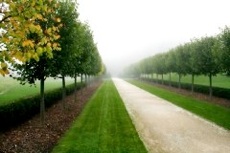
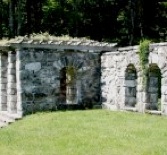
Top Left: The Lime (Linden) walk at The Mount (by David Dashiell).
Bottom: The Rose Garden, Naumkeag (from SUNY ESF Fletcher Steele Manuscript Collection).
Right: Frelinghuysen Morris House and Studio, entrance foyer.
